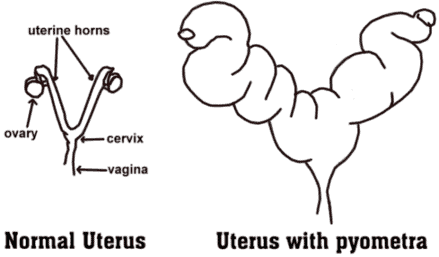Pyometra is the term for an abscessed, pus-filled infected uterus. Toxins and bacteria leak across the uterine walls and into the bloodstream, causing life-threatening effects and possible bacterial invasion into the bloodstream – septicemia.

Ultimately, the uterus dies, releasing large amounts of pus and dead tissue into the abdomen. Without quick treatment death is inevitable. Prevention of this disease is one of the major reasons for routinely spaying female dogs.
Symptoms of Pyometra
Classically, the patient is an older female dog. Usually, she has finished a heat cycle in the previous 1 to 2 months. She has a poor appetite and may be vomiting or drinking an excessive amount of water. In the more usual “open pyometra,” the cervix is open and a smelly vaginal discharge is usually apparent.
There is also a form called a closed pyometra where the cervix is closed. In these cases, there is no vaginal discharge and the clinical presentation is more difficult to diagnose. These patients also tend to be sicker than those with open pyometra due to retention of the toxic uterine contents as well as a longer disease course prior to diagnosis.
Lab work shows a pattern typical of widespread infection that is often helpful in narrowing down the diagnosis. Radiographs may show a large distended uterus, though sometimes this is not obvious and ultrasound is needed to confirm the diagnosis.
How Does this Infection Occur?
Radiograph shows large tubular structures which
represent a pus-filled uterus

represent a pus-filled uterus
Traditional Treatment: Surgery
With each heat cycle, the uterine lining engorges in preparation for pregnancy. Eventually, some tissue engorgement becomes excessive or persistent (a condition called cystic endometrial hyperplasia). This lush glandular tissue is ripe for infection (recall that while the inside of the uterus is sterile, the vagina below is loaded with bacteria).
Bacteria ascend from the vagina and the uterus becomes infected and ultimately filled with pus. Hormonal effects on the uterine tissue accumulate with each heat cycle, which means pyometra is much more common in older females because they have experienced many hormonal cycles.
While pyometra surgery amounts to the same end result as routine spaying, there is nothing routine about a pyometra spay. As noted, the surgery is challenging and the patient is in a life-threatening situation and the uterine tissue is more firable.
For these reasons, the pyometra spay typically costs five to ten times as much as a routine spay.
While treatment for pyometra is surgical removal of the uterus and ovaries, it is crucial that the infected uterine contents do not spill and that no excess bleeding occurs.
The surgery is challenging, especially if the patient is toxic. Antibiotics are usually given at the time of surgery and may or may not be continued after the uterus is removed. Pain relievers are often needed post-operatively. A few days of hospitalization may be needed after the surgery is performed to provide supportive post-operative care and ensure the patient is stable.
Pros of surgery:
- The infected uterus is resolved rapidly (in an hour or two of surgery).
- Extremely limited possibility of disease recurrence.
What to be aware of:
- Surgery must be performed on a patient who could be unstable.
Prevention
Spaying represents complete prevention for this condition. The importance of spaying cannot be over-emphasized. Often an owner plans to breed a pet or is undecided, time passes, and then they fear she is too old to be spayed.
The female dog or cat can benefit from spaying at any age. The best approach is to figure that pyometra is highly likely to occur if the female pet is left unspayed; any perceived risks of surgery are very much out-weighed by the risk of pyometra.


